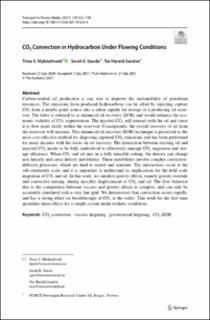| dc.contributor.author | Mykkeltvedt, Trine Solberg | |
| dc.contributor.author | Gasda, Sarah Eileen | |
| dc.contributor.author | Sandve, Tor Harald | |
| dc.date.accessioned | 2022-03-11T09:03:53Z | |
| dc.date.available | 2022-03-11T09:03:53Z | |
| dc.date.created | 2022-03-10T10:15:20Z | |
| dc.date.issued | 2021 | |
| dc.identifier.citation | Transport in Porous Media. 2021, 139 155-170. | en_US |
| dc.identifier.issn | 0169-3913 | |
| dc.identifier.uri | https://hdl.handle.net/11250/2984514 | |
| dc.description.abstract | Carbon-neutral oil production is one way to improve the sustainability of petroleum resources. The emissions from produced hydrocarbons can be offset by injecting capture CO2 from a nearby point source into a saline aquifer for storage or a producing oil reservoir. The latter is referred to as enhanced oil recovery (EOR) and would enhance the economic viability of CO2 sequestration. The injected CO2 will interact with the oil and cause it to flow more freely within the reservoir. Consequently, the overall recovery of oil from the reservoir will increase. This enhanced oil recovery (EOR) technique is perceived as the most cost-effective method for disposing captured CO2 emissions and has been performed for many decades with the focus on oil recovery. The interaction between existing oil and injected CO2 needs to be fully understood to effectively manage CO2 migration and storage efficiency. When CO2 and oil mix in a fully miscible setting, the density can change non-linearly and cause density instabilities. These instabilities involve complex convective-diffusive processes, which are hard to model and simulate. The interactions occur at the sub-centimeter scale, and it is important to understand its implications for the field scale migration of CO2 and oil. In this work, we simulate gravity effects, namely gravity override and convective mixing, during miscible displacement of CO2 and oil. The flow behavior due to the competition between viscous and gravity effects is complex, and can only be accurately simulated with a very fine grid. We demonstrate that convection occurs rapidly, and has a strong effect on breakthrough of CO2 at the outlet. This work for the first time quantifies these effects for a simple system under realistic conditions. | en_US |
| dc.language.iso | eng | en_US |
| dc.rights | Navngivelse 4.0 Internasjonal | * |
| dc.rights.uri | http://creativecommons.org/licenses/by/4.0/deed.no | * |
| dc.title | CO2 Convection in Hydrocarbon Under Flowing Conditions | en_US |
| dc.type | Peer reviewed | en_US |
| dc.type | Journal article | en_US |
| dc.rights.holder | © The Authors, 2021 | en_US |
| dc.description.version | publishedVersion | en_US |
| cristin.ispublished | true | |
| cristin.fulltext | original | |
| cristin.qualitycode | 2 | |
| dc.identifier.doi | 10.1007/s11242-021-01653-8 | |
| dc.identifier.cristin | 2008718 | |
| dc.source.journal | Transport in Porous Media | en_US |
| dc.source.volume | 139 | en_US |
| dc.source.pagenumber | 155-170 | en_US |
| dc.relation.project | Norges forskningsråd: 230303 | en_US |
| dc.relation.project | Norges forskningsråd: 255510 | en_US |
| dc.relation.project | Norges forskningsråd: 268439 | en_US |

